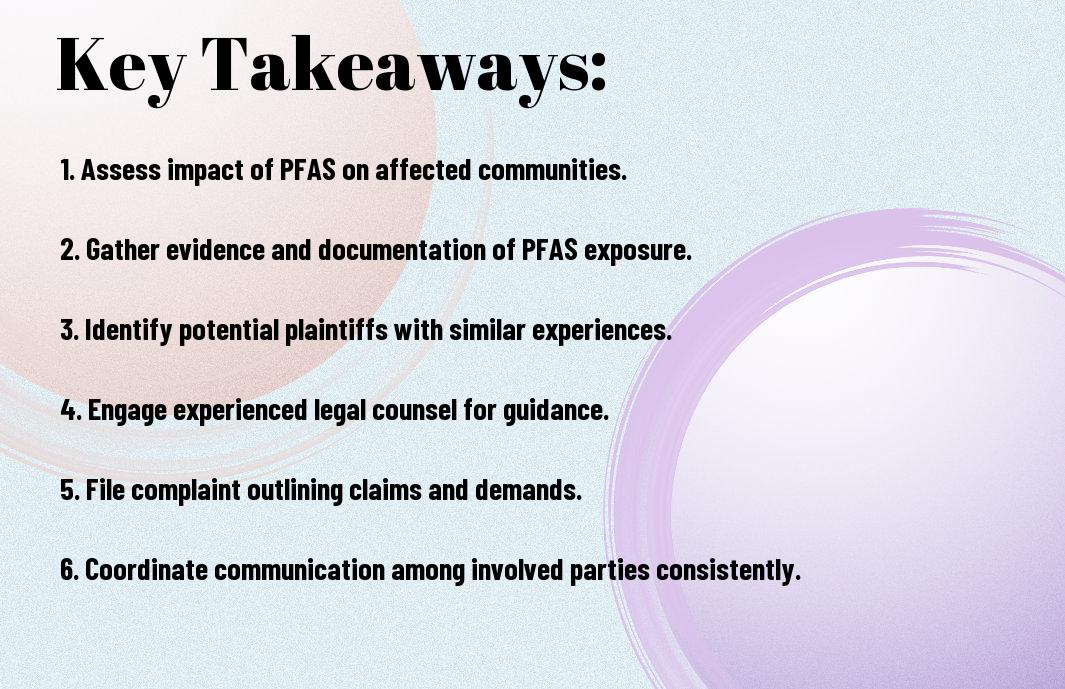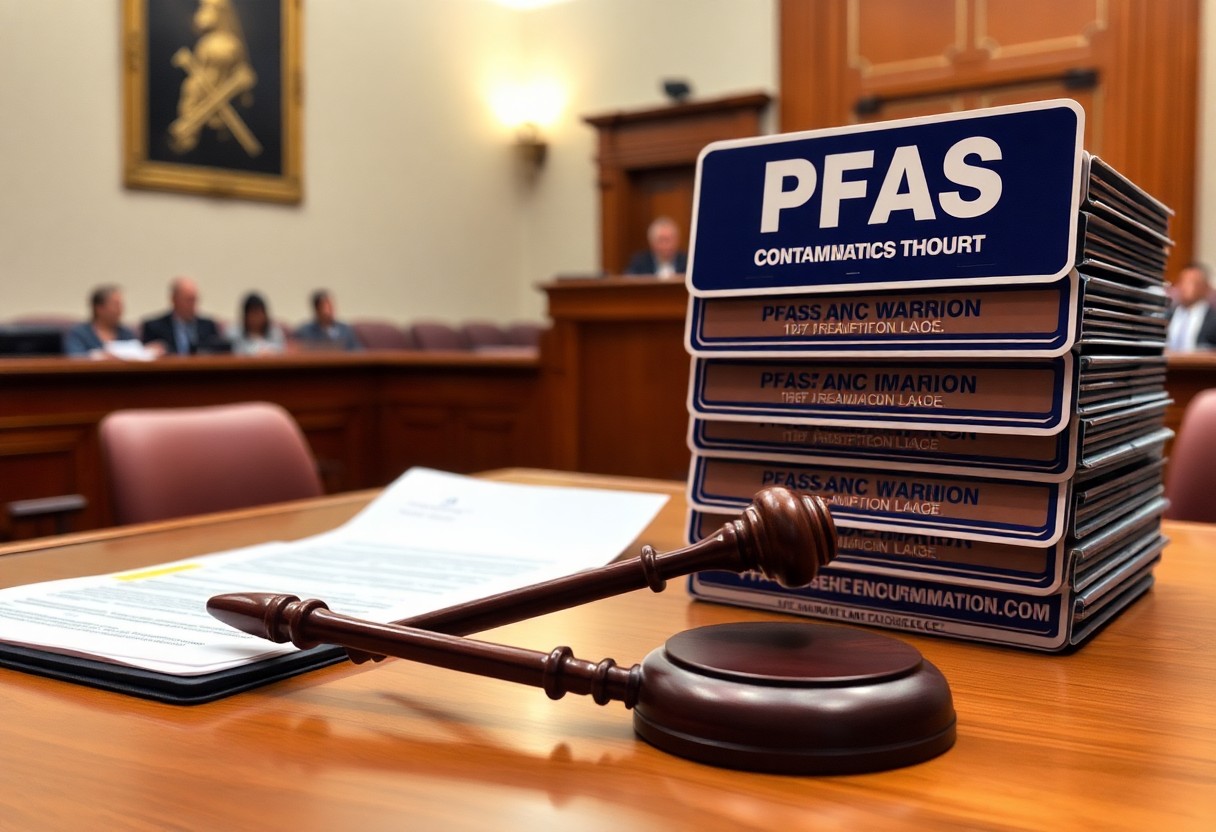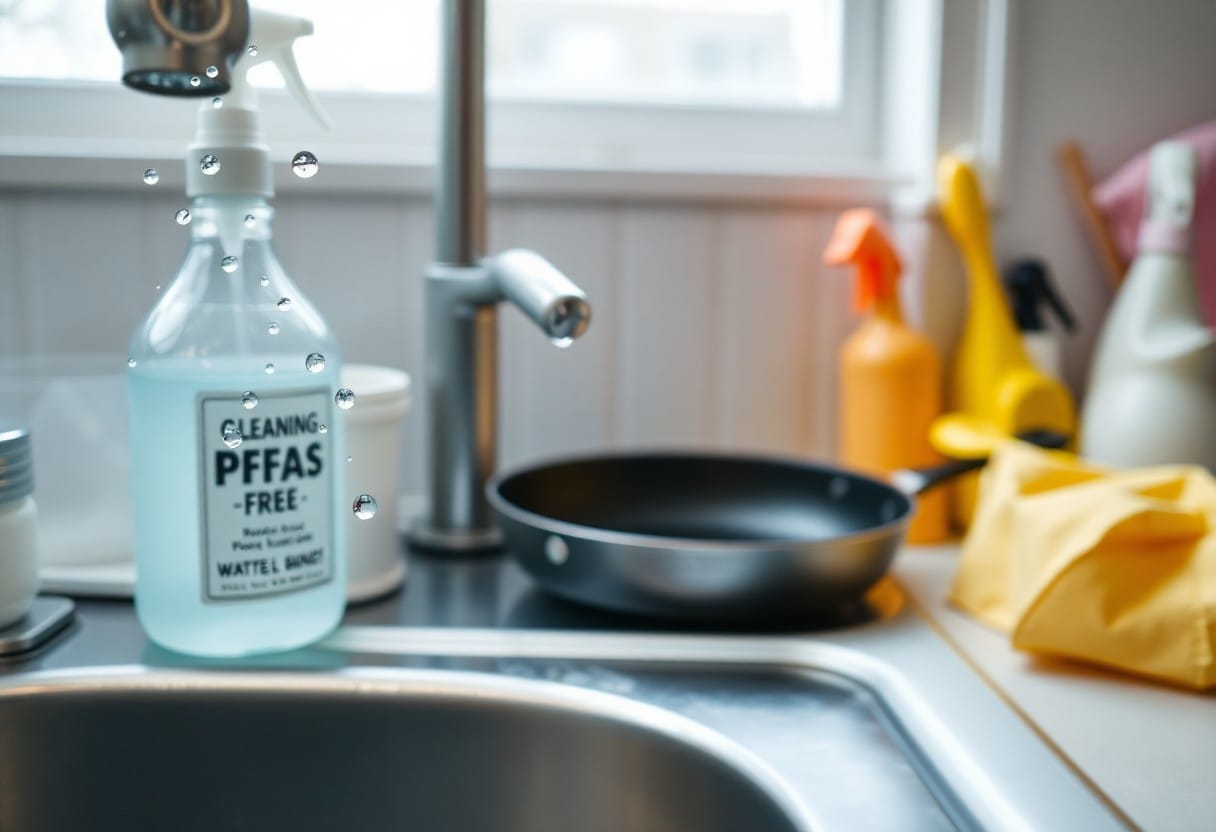Over the past decade, the growing concerns surrounding PFAS contamination have prompted individuals to seek justice through class action lawsuits. If you find yourself affected by these harmful substances, organizing a successful lawsuit is imperative to hold responsible parties accountable. This listicle outlines 10 actionable steps you can take to build a strong foundation for your class action PFAS lawsuit, empowering you to advocate for your rights and those of your community effectively.

Identify Affected Individuals
The first step in organizing a successful class action PFAS lawsuit is to identify individuals affected by PFAS contamination. You must gather information about communities exposed to these harmful chemicals, focusing on specific locations known for high levels of contamination. This will help in establishing a strong foundation for your case and ensure you include all impacted parties.
Gather Data on Exposure
While identifying affected individuals, it’s imperative to gather comprehensive data on their exposure to PFAS. You should collect evidence from environmental reports, water quality tests, and medical records that document the presence of PFAS in your community. This data is vital in demonstrating the extent of exposure and its potential effects on health.
Reach Out to Potential Plaintiffs
Gather information about the individuals who may have been impacted by PFAS and reach out to them to gauge their interest in joining the lawsuit. You can utilize community meetings, social media platforms, or local advocacy groups to connect with potential plaintiffs. Effective outreach can create a strong network of individuals willing to share their experiences and testify about the effects of their PFAS exposure.
Reach out to potential plaintiffs using various communication channels. Hosting informational sessions can help articulate the lawsuit’s purpose and engage interests and concerns. You might also develop informational brochures or online platforms to provide comprehensive details about PFAS exposure and its implications. Establishing rapport and trust with those affected will encourage them to come forward and share their stories for the collective case.
Choose Appropriate Legal Counsel
It is imperative to select legal counsel that specializes in class action lawsuits, particularly those related to PFAS contamination. Your attorney will guide you through the complexities of litigation, ensuring that all necessary legal procedures are followed and that your case is presented effectively. Engaging the right lawyer can significantly impact the outcome of your lawsuit, so invest the time to find the best fit for your needs.
Find Experienced Class Action Lawyers
Assuming you are in the process of selecting legal representation, focus on finding lawyers with extensive experience in handling class action cases, specifically involving PFAS claims. An attorney well-versed in this area will be more equipped to navigate the unique challenges these cases present.
Evaluate Their Track Record
There’s a strong correlation between a lawyer’s track record and your lawsuit’s potential success. Investigating past cases can provide valuable insights into their effectiveness and expertise.
Class action lawyers with a proven history in PFAS litigation will have demonstrated both successful case outcomes and an ability to manage complex legal procedures. Look for testimonials from previous clients, settlements or verdicts in similar cases, and overall reputation in the legal community. By understanding their past performance, you can make an informed decision that aligns with your goals for a successful lawsuit.
Assess the Legal Basis
Even before proceeding with a class action lawsuit regarding PFAS contamination, it’s important to assess the legal basis for your claims. This involves examining the laws and legal frameworks that govern environmental pollution and toxic torts. Understanding these legal parameters will help clarify whether your case meets the necessary criteria, and which specifics you will need to prove to advance your claims effectively.
Review Relevant Laws
There’s a myriad of federal and state regulations that govern environmental contamination. You must familiarize yourself with statutes like the Comprehensive Environmental Response, Compensation, and Liability Act (CERCLA), as well as state-specific environmental laws. These laws will provide the foundational knowledge necessary for structuring your legal argument effectively.
Determine Viable Claims
There’s more than one potential legal avenue to pursue in a PFAS class action. Determining which claims are viable depends on a careful analysis of the specific facts surrounding your case, including the nature of the PFAS exposure, the effects on affected parties, and the environment. This step requires you to assess not only the environmental impact but also any potential negligence or liability issues that could support your claim.
The determination of viable claims is an in-depth process that demands careful consideration of various elements. You’ll want to gather evidence, such as documentation of PFAS presence, health records, and testimonies, to support your claims. Factors such as time limits for filing, the ability to prove harm, and jurisdiction will influence your decisions. Consulting with an experienced attorney will significantly aid you in identifying which claims can realistically be pursued and how best to structure your lawsuit.
Collect evidence and documentation
Your success in a class action PFAS lawsuit hinges on gathering solid evidence and thorough documentation. This includes securing any relevant environmental data and personal health records that demonstrate the extent of exposure and its effects. The more comprehensive your evidence, the stronger your case will be when advocating for justice and accountability against those responsible for PFAS contamination.
Compile environmental data
One of the first steps in collecting evidence is to compile environmental data related to PFAS exposure in your area. This might include public records, scientific studies, and reports from environmental agencies that detail contamination levels and sources. Gathering this data forms the foundation of understanding the scope of the issue, helping to establish a link between pollution and its adverse effects on the community.
Gather personal health records
Now is the time to gather personal health records for you and others who have been affected by PFAS exposure.
A systematic collection of health records can provide evidence of any medical conditions linked to PFAS, such as certain cancers, liver damage, and reproductive issues. This documentation will not only help build a compelling case but also highlight the personal impact contaminated environments have had on individuals. Getting detailed records from healthcare providers, including diagnoses, treatment histories, and any relevant tests, will aid in establishing the correlation between exposure and health effects in your lawsuit.
Establish a Class Definition
All participants in a class action PFAS lawsuit must be clearly defined to ensure effective representation and communication. Establishing a precise class definition helps to identify who will be included in the lawsuit and sets the parameters for the claims being made. This step is vital for gathering appropriate evidence and achieving a favorable outcome for all involved.
Define Common Characteristics
You’ll need to identify the key characteristics that members of your class share. This could include factors like the type of PFAS exposure, the nature of the harmful effects experienced, or the product associated with the contamination. By honing in on these commonalities, you create a cohesive group ready to pursue collective action.
Clarify Geographic Boundaries
An important aspect of establishing your class definition is determining the geographic area affected by PFAS contamination. Narrowing down the location helps to identify potential claimants who have experienced similar damages due to the same source of PFAS exposure.
Defining the geographic boundaries allows you to focus on specific communities or regions where individuals have been similarly impacted by PFAS. This can involve analyzing environmental studies, health assessments, and publicly available data about contamination levels. By doing so, you effectively create a clear framework that not only strengthens your case but also ensures that you are representing all harmed individuals within the designated area.
Prepare class certification motion
Not every class action lawsuit will qualify for certification, so it is crucial to prepare a robust class certification motion. You must demonstrate that your case meets the required legal standards, including commonality, adequacy, typicality, and predominance. This step can significantly affect the trajectory of your case, as successful certification allows the claims of all class members to be heard collectively.
Draft legal documents
An important part of your preparation involves drafting the legal documents necessary for the certification process. You will need to create a detailed motion that outlines your arguments while adhering to specific legal standards. Including supporting affidavits and evidence will bolster your case, helping establish the legitimacy of your class.
Present evidence to court
Evidence is vital to prove that the proposed class meets all requirements for certification. You will need to compile and present robust documentation that supports the claims of your class members.
Motion practice can include witness testimonies, expert reports, and other relevant documents that validate your position. You will also want to address any potential objections raised by the opposing party. A well-prepared presentation of this evidence will maximize your chances of obtaining class certification and moving forward with your lawsuit.
Notify Potential Class Members
Keep your potential class members informed and engaged throughout the lawsuit process. Effective communication is key to ensuring that all interested parties are aware of their rights, the status of the lawsuit, and any important deadlines. This helps build a strong foundation for your class action by fostering a sense of community among members and encouraging participation.
Develop Notification Plan
While crafting a notification plan, consider various channels that will reach your target audience effectively. This may involve using direct mail, email, social media, and local community outreach. Tailor your messages to suit different demographics to ensure clarity and resonance.
Disseminate Information Effectively
Potential class members should receive clear, comprehensive, and timely information about the lawsuit. Your strategy should include both traditional media and digital platforms to maximize coverage and access.
Notification materials should outline the details of the lawsuit, including the allegations, potential damages, and the benefits of joining the class action. Be transparent about the process, deadlines, and how members can participate. Use simple language to avoid confusion, and consider creating a dedicated website or FAQ page where individuals can easily access up-to-date information. Engaging visuals and compelling messaging can also help capture attention and encourage involvement.
Conduct Preliminary Hearings
Many individuals may find themselves overwhelmed during the initial stages of organizing a class action PFAS lawsuit. Conducting preliminary hearings allows you to establish the foundation of your case, gauge the strength of your claims, and understand the interests of potential class members. These early meetings can help outline key points, clarify expectations, and outline the next steps needed for a successful class action lawsuit.
Address Legal Challenges
An effective class action lawsuit must anticipate and address potential legal challenges. This can include understanding jurisdictional issues, statutes of limitations, or the specific legal standards required for class certification. By identifying these challenges early, you can bolster your case and ensure that you are prepared for arguments posed by the opposing party.
Advocate for Class Action
For a successful class action lawsuit, you need to vigorously advocate for the interests of the class you represent. This involves not only educating potential class members about their rights but also demonstrating the importance and benefits of coming together as a united front. You will want to highlight how a class action can be more effective than individual lawsuits, particularly when it comes to complex cases like PFAS contamination.
Plus, advocating for a class action helps foster a sense of community among affected individuals. By encouraging them to join forces, you amplify their voices and strengthen the pursuit of justice. This collective effort is instrumental in adding weight to your case, showcasing the extent of the impact caused by PFAS, and potentially leading to higher settlements or judgments against responsible parties.
Plan for Settlement or Trial
For a successful PFAS class action lawsuit, you must develop a clear plan for either settlement or trial. This involves assessing the potential outcomes and preparing your strategy based on the strengths of your case. You will need to evaluate settlement offers, weigh their adequacy against your goals, and also be prepared for the possibility of going to trial if negotiations do not yield satisfactory results.
Evaluate Settlement Options
Options for settlement should be carefully assessed to determine what best serves your interests and those of the class. Consider the compensation offered, along with any non-monetary benefits such as changes in practices or accountability measures from the defendant. Collaborate with your legal team to gauge whether a settlement aligns with the group’s goals and expectations.
Prepare for Courtroom Presentation
You will need to prepare extensively for your courtroom presentation. This involves organizing key evidence, developing a clear narrative, and anticipating counterarguments. Effective communication and a persuasive delivery will be vital to convey the significance of your case to the judge or jury.
This preparation should include rehearsing your presentation with your legal team, ensuring that all members understand their roles during the trial. You might want to conduct mock trials to assess the effectiveness of your arguments and witness testimonies. Visual aids, such as graphs or charts highlighting PFAS exposure data, can help reinforce your case. Thorough preparation not only boosts your confidence but also enhances the clarity and impact of your presentation, increasing the likelihood of a favorable outcome.

To wrap up
Ultimately, organizing a successful class action PFAS lawsuit requires careful planning and execution. By following the ten steps outlined, you can effectively gather evidence, build a strong case, and mobilize your community. Engage with experienced legal professionals, stay informed about regulatory developments, and maintain communication with your fellow plaintiffs. Your efforts can contribute to holding responsible parties accountable and seeking justice for those affected by PFAS contamination. Approach the process with diligence and determination, knowing that collective action can lead to significant change.


















